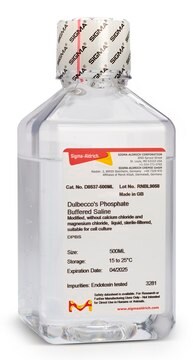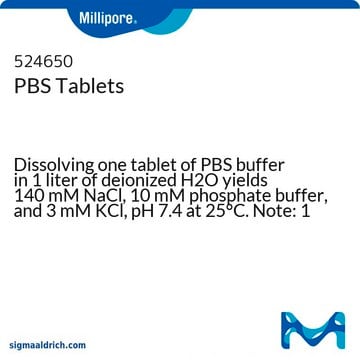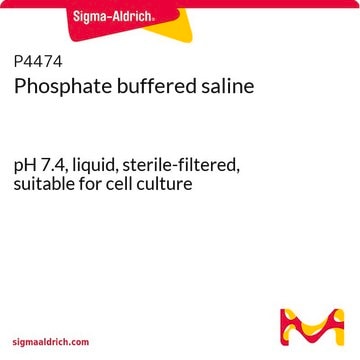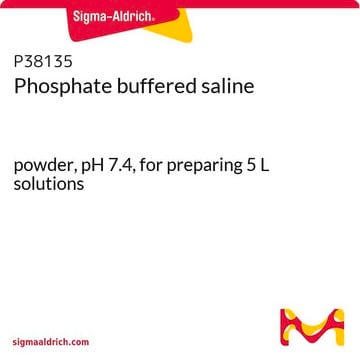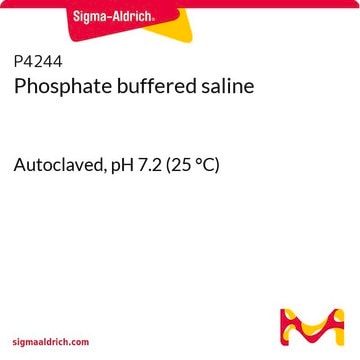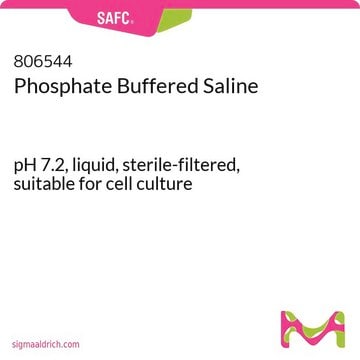Products may be shipped at a different temperature than the recommended long-term storage temperature. If the product quality is sensitive to short-term exposure to conditions other than the recommended long-term storage, it will be shipped on wet or dry-ice. If the product quality is NOT affected by short-term exposure to conditions other than the recommended long-term storage, it will be shipped at ambient temperature. As shipping routes are configured for minimum transit times, shipping at ambient temperature helps control shipping costs for our customers. For more information, please refer to the Storage and Transport Conditions document: https://www.sigmaaldrich.com/deepweb/assets/sigmaaldrich/marketing/global/documents/316/622/storage-transport-conditions-mk.pdf
P3813
Disolución salina tamponada con fosfato
powder, pH 7.4, for preparing 1 L solutions
Sinónimos:
PBS
Seleccione un Tamaño
Seleccione un Tamaño
About This Item
Productos recomendados
Nombre del producto
Disolución salina tamponada con fosfato, powder, pH 7.4, for preparing 1 L solutions
Quality Level
form
powder
storage condition
dry at room temperature
color
white
pH
7.4
solubility
water: soluble
density
1.19 g/cm3 at 20—25 °C
1.22 g/cm3 at 20—25 °C
application(s)
diagnostic assay manufacturing
life science and biopharma
sample preparation
¿Está buscando productos similares? Visita Guía de comparación de productos
General description
La capacidad de amortiguación de PBS, mantenida a través de un equilibrio fosfato-ácido fosfórico, proporciona un entorno de pH estable crucial para una actividad enzimática óptima y varios procesos biológicos. Esto hace que PBS sea ideal para la preparación de reactivos, la diálisis de proteínas y la inmunohistoquímica, asegurando resultados uniformes y fiables en los experimentos. Más allá de la biología celular, PBS puede también encontrar aplicaciones en diversas áreas, como la creación de tampones ELISA personalizados para asegurar interacciones óptimas entre anticuerpos y antígenos. Además, PBS puede actuar como tampón de migración para la cromatografía en proteína A/G, facilitando la purificación de anticuerpos en función de su unión específica al antígeno. En procedimientos hematológicos y bioquímicos, PBS es muy utilizado para el lavado de células y tejidos.
En resumen, PBS emerge como una herramienta indispensable en la investigación biológica y bioquímica, ofreciendo isotonicidad, capacidad de amortiguación, simplicidad y estabilidad. Sus diversas aplicaciones en biología celular, preparación de reactivos, purificación de proteínas y diversos ensayos biológicos subrayan su importancia en el avance del conocimiento y la comprensión científicos.
Application
- en las disoluciones de lavado durante el procedimiento de inmunofluorescencia.[1]
- para la suspensión de células bacterianas.[2]
- durante los procedimientos de fijación e inmunotinción.[3]
- para enjuagar tejidos fijados y crear un ambiente de amortiguación adecuado en el proceso de inmunolocalización[4]
- como diluyente para evaluar el rendimiento de un kit de prueba ELISA[5]
- como amortiguador en un procedimiento de inmunohistoquímica[6][3]
Features and Benefits
- Producto de gran calidad adecuado para múltiples aplicaciones experimentales
- Puede utilizarse como un componente amortiguador en aplicaciones biológicas y bioquímicas
- Muy hidrosoluble
Packaging
Reconstitution
Other Notes
Storage Class
13 - Non Combustible Solids
wgk_germany
WGK 3
flash_point_f
Not applicable
flash_point_c
Not applicable
Elija entre una de las versiones más recientes:
Certificados de análisis (COA)
¿No ve la versión correcta?
Si necesita una versión concreta, puede buscar un certificado específico por el número de lote.
¿Ya tiene este producto?
Encuentre la documentación para los productos que ha comprado recientemente en la Biblioteca de documentos.
Los clientes también vieron
Artículos
This is a protocol for a Membrane Integrity test for Lipid-PAMPA Artificial Membranes
Protocolos
ICC Cell Capture Imaging Reagent simplifies imaging, ideal for rare cell and low cell count samples.
Cell staining can be divided into four steps: cell preparation, fixation, application of antibody, and evaluation.
Assays that predict passive absorption of orally administered drugs have become increasingly important in the drug discovery process. As previously described by Faller and Kansy such assays provide rapid, low cost and automation friendly methods to measure a compound’s passive permeability.
Strat-M® synthetic membrane mimics the human skin for In-vitro permeation testing (IVPT) of topical and transdermal formulations
-
How is shipping temperature determined? And how is it related to the product storage temperature?
1 answer-
Helpful?
-
-
How can I determine the shelf life / expiration / retest date of this product?
1 answer-
If this product has an expiration or retest date, it will be shown on the Certificate of Analysis (COA, CofA). If there is no retest or expiration date listed on the product's COA, we do not have suitable stability data to determine a shelf life. For these products, the only date on the COA will be the release date; a retest, expiration, or use-by-date will not be displayed.
For all products, we recommend handling per defined conditions as printed in our product literature and website product descriptions. We recommend that products should be routinely inspected by customers to ensure they perform as expected.
For products without retest or expiration dates, our standard warranty of 1 year from the date of shipment is applicable.
For more information, please refer to the Product Dating Information document: https://www.sigmaaldrich.com/deepweb/assets/sigmaaldrich/marketing/global/documents/449/386/product-dating-information-mk.pdfHelpful?
-
-
Does P3813 PBS (Phosphate Buffered Saline) contain calcium or magnesium?
1 answer-
The composition of P3813 PBS Phosphate Buffered Saline is considered proprietary, but the website provides the following information. When one pouch is dissolved in one liter of distilled or deionized water, it yields 0.01 M phosphate buffered saline with a pH of 7.4 at 25°C, consisting of NaCl at 0.138 M and KCl at 0.0027 M.
Helpful?
-
-
Is autoclaving necessary for PBS P3813 before conducting the presence-absence test for coliform bacteria?
1 answer-
No, phosphate buffers by themselves are generally not autoclaved due to the common occurrence of precipitate formation. Autoclaving is commonly used in microbiology, but if your test method only requires sterilization without specifying autoclaving, filter sterilization might be a better option to consider.
Helpful?
-
-
Good morning, I would like to know what PKG means in kg. I would also like information about the validity of the solution resulting from the dissolution of the solid in question. Thanks
1 answer-
PKG means package. One package is one pouch. As per its COA: https://www.sigmaaldrich.com/certificates/sapfs/PROD/sap/certificate_pdfs/COFA/Q14/P3813-1PAK0000291289.pdf, each pouch contains 9.07-10.00 g of powder. And the pH and dissolution time are tested to validate the solution.
Helpful?
-
-
hi, what kg is in one package?
1 answer-
The amount of powder to prepare 1 liter of buffer is approximately 9.55 grams.
Helpful?
-
-
Does this PBS contain Ca and Mg?
1 answer-
No, the components of this formulation do not include calcium or magnesium.
Helpful?
-
-
What is the salinity of Phosphate buffer saline P3813?
1 answer-
As mentioned on the product detail page, the contents of one pouch, when dissolved in one liter of distilled or deionized water, will yield 0.01 M phosphate buffered saline (NaCl 0.138 M; KCl - 0.0027 M); pH 7.4, at 25 °C.
Helpful?
-
-
How much is in each pouch of Product P3813, Phosphate buffered saline?
1 answer-
Each pouch of phosphate buffered saline contains 8 g sodium chloride (e.g. Product No. S9625), 0.2 g potassium phosphate, monobasic (e.g. Product No. P5379), 1.15 g sodium phosphate, dibasic (e.g. Product No. S0876), 0.2 g potassium chloride (e.g. Product No. P4504), giving a total 9.55 g per packet. This is the standard PBS formulation.
Helpful?
-
-
How long can solutions of Product P3813, Phosphate buffered saline, be kept once prepared?
1 answer-
Sigma Aldrich has not evaluated the solution stability, but sterile solutions of PBS stored at 2-8°C can be expected to be stable for several months.
Helpful?
-
Active Filters
Nuestro equipo de científicos tiene experiencia en todas las áreas de investigación: Ciencias de la vida, Ciencia de los materiales, Síntesis química, Cromatografía, Analítica y muchas otras.
Póngase en contacto con el Servicio técnico
